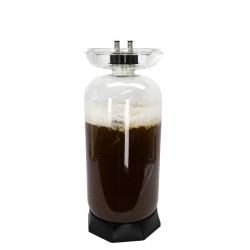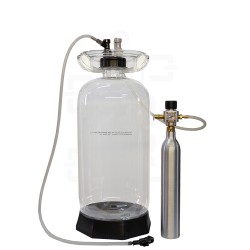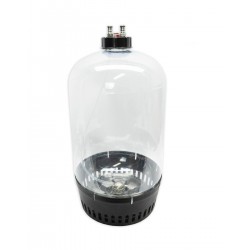6509
Data publikacji:10
MAR
2023
Pressure fermentation - how to start?
Pressure fermentation of beer has been an issue of increasing interest to home brewers for several years. The number of users of pressure fermenters is growing year by year and there are many indications that this method will revolutionize home brewing in the near future. What is hidden in it that, both in terms of use and final taste effects, this method of fermentation has stolen the hearts of those who have already started their adventure with it?
What is pressure fermentation?
As the name suggests, it is a fermentation at above atmospheric pressure. PSI or bar units are used for pressure measurements in this method. The pressure at which we ferment beers with this method usually oscillates between 10PSI / 0.7 bar and 20PSI / 1.4 bar.
The gas we use to pressurize the fermenter is carbon dioxide. The tank in which we carry out the fermentation must allow you to control the pressure inside and maintain it at a certain level. Maintaining the pressure at the right level is crucial for the work of yeast and the effects of fermentation. If the pressure in the fermenter gets too high and uncontrollable, it can disturb or even stop the yeast from working. Depending on the type of beer that we ferment, we set the pressure in the fermenter at the appropriate level from the beginning of fermentation, letting CO2 inside from the bottle, or let it be produced naturally in the following days of fermentation. In both cases, it is important to set the pressure safety devices in the fermenter.
As a curiosity, it is worth noting for comparison that the pressure value in a plastic 2l bottle of Coca Cola is about 45 PSI / 3.2 bar. As you can see, the pressure values during pressure fermentation of beer are not very high.
What is pressure fermentation?
Since we briefly know what the pressure fermentation process is all about, we need to ask ourselves why do we need it and what do we gain thanks to it? The most characteristic features of this method are:
saturation of beer with CO2 in the fermenter without the need for reference after bottling.
very clean flavor profile of pressure-fermented beer - no esters, no diacetyl.
better preservation of aromas in beer, which do not evaporate with carbon dioxide.
no contact with oxygen
faster fermentation.
What does this mean in practice?
The CO2-saturated beer is practically ready to drink right after bottling. This is especially true for styles that do not require longer aging. The more so that the increased pressure does not accelerate the fermentation process. Thanks to this, we can enjoy the finished beer much faster than in the case of traditional fermentation. As a matter of fact, beer can be served straight from the fermenter using a special tap. Equipment manufacturers have even prepared special kegs/fermenters for this purpose, in which we can take beer to a party right after fermentation.
However, the saturation of beer during fermentation seems to be secondary to the taste values obtained by this method. What particularly impresses brewers is the clean profile of the beer. Fermenting under pressure, the yeast practically does not produce esters or fusels, working even at a temperature of about 20 degrees C. Thanks to this, we can ferment bottom-fermented beers at room temperature, obtaining excellent results in a short time. For such fermentation, we use typical bottom-fermenting yeast. Interestingly, thanks to pressure fermentation, diacetyl in beer is not perceptible - a characteristic slightly buttery aftertaste.
In the case of ales, where the appropriate level of esters is desired, the fermentation process must be slightly different. In the first days of fermentation, we practically do not maintain elevated pressure in the fermenter, raising it only after about 2-3 days of yeast operation. For lager yeast, the recommended pressure is 15-20PSI / 1-1.4 bar, for lager yeast, a lower pressure of about 10 PSI / 0.7 bar is recommended.
Fermentation in a sealed fermenter also results in better absorption of aromas by the fermenting wort. During classic fermentation, a large part of the aromas of both hops and malt evaporates with the escaping CO2. During pressure fermentation, these aromas pass into the beer much more strongly.
Another feature of this fermentation is the ability to ferment and store beer without contact with oxygen. This is important for the longer preservation of taste. Oxygen is a factor that significantly accelerates the aging of beer. This is manifested by the characteristic aftertaste of honey, toffee or wet cardboard in aged beer.
Classically fermenting beer at home, we are practically unable to avoid its oxygenation, whether during transfer to silent fermentation or during bottling. Oxygen is also present in the fermentation bucket. The presence of oxygen during fermentation creates conditions for the growth of bacteria often responsible for beer infections. During properly conducted pressure fermentation, the above phenomena are strongly limited.
Fermentation processes under pressure occur much faster than in the classical method.
Working time still depends on the characteristics of the yeast used and the density of the wort. However, it can be expected that we need half the time for fermentation under pressure than in open fermentation. Also, the maturation of beer after fermentation proceeds faster under pressure conditions.
The above features of pressure fermentation are its undoubted advantages. However, it is not without some difficulties compared to classical fermentation.
These include, above all, the bottling of beer. Classically fermenting beer. we pour beer into bottles by gravity through a tap in the fermenter. To bottle from a pressure fermenter we need a bit more advanced equipment. The bottles must be filled with CO2 and should be pressurized to the pressure in the fermenter. This will prevent the beer from foaming when bottling. For this purpose, the simplest solution is a beer gun pressure beer dispenser and a CO2 cylinder with a reducer. We connect the equipment to the fermenter, fill the bottle with CO2 and then pour the beer and cap it. It is important with this method to cool the beer in the fermenter to a few degrees Celsius, which helps to limit beer foaming.
We have much less problems with beer kegs. Just connect the keg with a hose to the fermenter, equalize the pressure from the CO2 bottle and transfer the beer to the keg. In this case, such a spill is very convenient and matters. Also, there is no need to additionally cool the beer before bottling. For these reasons, most brewers pressure fermenting at home keg their beers.
What equipment do we need?
Deciding to start pressure fermentation, we need to slightly expand our brewery. Both fermenters and beer bottling equipment will be needed. A certain solution are kegs in which we ferment and we can immediately run a beer tavern from them
Pressure fermenter Apollo 30 - allows you to carry out pressure fermentation in the range. It is distinguished by a thicker and stronger material from which it is made and the attached safety valves that allow fermentation in three pressure ranges without the need to buy additional valves. Unitank has been equipped with three different overpressure valves (PRV), blue 0.7 bar (10PSI), purple 1.0 Bar (15PSI) and red 2.4 bar (35PSI)
To control the pressure more precisely, you can buy a Keg King Spundy or Keg King Spunding Valve. The Spundy valve does not require additional hoses and connectors, it is enough to mount it on a gas connector of the Cornelius Corny type. Built-in pressure gauge lets you see exactly what pressure your keg is holding, from 0 to 30 PSI (2 Bar)
The Spunding Valve also does not require additional hoses and connectors, it is mounted on the ball-lock end of the Cornelius Corny gas. This valve allows for more accurate pressure regulation up to 15PSI/1bar.
Fermenter Keg King Junior - The Fermenter King Junior is a 20L pressurized fermenter and keg capable of fermenting up to 18L of wort under pressure, 2.4 bar (35 psi) maximum. It is made of crystal clear PET plastic, with a form of a shape that increases its strength.
The King Junior is supplied complete with a pressure cover fitted with corny conelius IN and OUT valves and a safety valve. The liquid valve is attached to a silicone tube, which floats on the surface thanks to the float ball, which allows you to collect clear beer from the top of the keg. Its relatively small size of 26 x 57 cm makes it easy to fit in a kegerator or fridge after fermentation.
Fermenter Keg King Chubby 30L - The Fermenter Chubby is a 30L pressurized fermenter and keg capable of fermenting up to 25L of wort under pressure, 2.4 bar (35 psi) maximum. It is made of crystal clear PET plastic, molded to increase its durability with a stainless steel handle for easy carrying. The Chubby is supplied complete with a pressure cover fitted with corny conelius IN and OUT valves and a safety valve. The liquid valve is attached to a silicone tube which, thanks to the float ball, floats on the surface, allowing you to receive clear beer from the top of the keg.
The equipment available on the market makes pressure fermentation, previously available mainly for professional breweries, become simple and convenient also for home brewers.



























Dodaj komentarz
0 komentarze